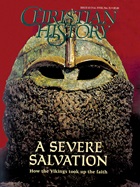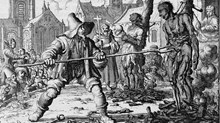In one sense, Iceland began as a Christian land. The earliest history of the volcanic island, Ari Thorgilsson's Islendingabók records, "There were Christian men here, whom the Norsemen call 'papa' (priest); and they later went away, since they did not want to be here with the heathen men, and they left behind Irish books and bells and crooks, from which one might judge they were Irishmen."
But when the Irish monks left, Iceland was left to Norwegian settlers with their own religious customs—some Christian, some pagan. The clash between beliefs was not unlike that in the rest of the Viking world at the time, but its resolution is one of the most unexpected conversion stories in the world.
Lampooners and hotheads
Iceland, called the ultima Thule in ancient geography, first came to the attention of Norwegian Vikings intent on settlement in the year 870. There were already Christians among the early settlers, people such as Audh the Deep-Minded, who wished to be buried beneath the water line, to be able to touch the same living water as Jerusalem.
Then there were some, such as Helgi the Lean, who believed in Christ but prayed to Thor when out on the sea. And there were those, like Hall and Thori Godhlaus, who claimed to have no religion, "trusting in their own might."
The Book of the Settlements (Landnamabok) would have us believe that Christianity, such as it was, died out after the first few generations, but we find Christians in Iceland throughout the era. We know that Irish missionaries came to convert the heathen, and Ari even mentions three "Armenian" bishops, Petrus, Abraham, and Stephanus.
The Vikings were, however, a rough lot and not easy to convert. Though their reputation for hostility to Christianity has been exaggerated, they were much given to lampoons and sneering verse. When a German Christian, Friedrich, came to Iceland with Thorvald the Far-Traveled in the 980s, two men made a poem accusing him and Thorvald of ergi (sexual perversion):
The Bishop [Friedrich] has borne nine children;
Thorvald was the father of all of them.
Thorvald slew the lampooners, so Friedrich and Thorvald had to leave Iceland. In spite of this, the Christian party was getting ever stronger on the island.
Meanwhile, Olaf Trygvesson had become King of Norway. Immediately upon taking the crown, he began forcibly Christianizing his kingdom (see "Be Christian or Die," p. 13). In 997 he sent his friend and court chaplain Thangbrand to Iceland to convert the island. According to another Icelandic chronicler, Thangbrand was "a passionate, ungovernable man, and a great manslayer; but he was a good scholar and a clever man."
He seems at first to have been quite successful, baptizing among others Hall of Sida, Hjalti Skeggjason, Gizur the White, "and many other distinguished men" who play key roles in Icelandic sagas and histories.
Nevertheless, Thangbrand shared the fate of his predecessor, Friedrich. "When he had been here one winter or two," writes Ari, "then he went away, and he had killed here two men or three, those who had lampooned him."
But it wasn't just the pagans who loved the ribald lampoons. Thangbrand's convert Hjalti, not the coolest of heads, pronounced his own ergi-verses in front of the Icelandic governmental assembly:
I don't want to blaspheme the gods,
But Freya seems to me a bitch.
Freya was the Venus of the pagan pantheon, and this very successful verse, containing an untranslatable pun (geyja means "to blaspheme", but also "to bark"), caused Hjalti to be banished from Iceland for three years.
Meanwhile, Thangbrand returned to Trygvesson a frustrated man, recounting all the problems he had in his missionary efforts, grumbling that Iceland would probably never be converted.
The king was not known for his even temper, and he threatened to maim or kill all the Icelanders he could round up in Norway.
The exiled Icelanders Gizur and Hjalti were in Norway at this time and managed an audience with Trygvesson (who was actually Gizur's cousin). They convinced the king to cancel his massacre and persuaded him to let them make one more try at converting Iceland.
"They were of no other expectancy than that they would succeed," Ari notes.
One law, one faith, mass baptism
Almost from the first settlement, Iceland was divided into quarters, with generally three things (courts, or local assemblies) in each quarter.
An Althing, a kind of superior court or general assembly, met every summer on Iceland's southwestern Thingvellir plains.
Iceland's legal code had not yet been completely put in writing, so one of the main features at the Althing was the Law-Sayer's recitation of one-third of the law. Every three years, the entire legal code would be transmitted to the assembly in this way.
Gizur, Hjalti, and companions arranged to arrive in Iceland as the Althing was opening in the summer of 1000. They left Hjalti behind, since he had been outlawed for lampooning Freya, and made their way toward Thingvellir. On their way, they learned that their enemies intended to forbid them entrance to the Althing by force—a common tactic—so they paused and sent word to their helpers to come to meet them.
While they were hesitating, Hjalti came riding up with his 11 men. Together with their helpers they broke the blockade. A battle was so narrowly avoided, says Ari, "that you couldn't tell the difference."
The next day, Gizur and Hjalti went to the Law-Mound to preach their message. "It is said that it was remarkable how well they spoke," Ari recounted. The substance is unknown, but we may be sure that they stressed the displeasure of Olaf Trygvesson and that they relied on his backing.
The result was predictable: the Christians and the heathens each refused to follow the others' laws and declared each other criminals.
The Christians asked one of their own, Hall of Sida, to announce the law that the Christians were to follow, but he paid the heathen Law-Sayer Thorgeir to do it. When the people retired to their booths, Thorgeir lay down and spread his cloak over him (perhaps a vestige of pagan shamanism). He remained there all day and the next night without saying a word. The next morning he sat up and told everyone to go to the Law-Mound.
Thorgeir the Law-Sayer, above all, knew the importance the law played in Icelandic society. Two separate, armed camps following different laws would destroy the community. They would inevitably come to blows, desolating the land. Thorgeir referred to the examples of other countries, particularly Norway and Denmark, where bloodshed had been avoided when one law was forced upon the warring parties.
"If we tear the law asunder," he said, "we may also rend the peace." The two sides agreed they would indeed adopt one law, be it pagan or Christian, which Thorgeir had yet to announce.
"Then it was said in the law," recounts Ari, "that all men should be Christians and those be baptized who before were unbaptized before here in Iceland." But the mass conversion came with several compromises: the old laws allowing the exposure of infants and the eating of horseflesh would continue. And people could continue to sacrifice according to pagan custom but only in secret; if they were caught sacrificing, they would be outlawed for three years.
("A few winters later," Ari notes, "these heathen practices were taken away like the others.")
And thus did Christianity come to Iceland. Isleif, Gizur's son, became bishop at Skalholt, and the land slowly (and with its share of bloodshed) became the very model of a Christian state.
James Marchand is professor emeritus at the University of Illinois at Urbana-Champaign. His English translation of Islendingabók is online at www.lang.uiuc.edu/LLL/etexts/
Copyright © 1999 by the author or Christianity Today/Christian History magazine.
Click here for reprint information on Christian History.

Support Our Work
Subscribe to CT for less than $4.25/month






























